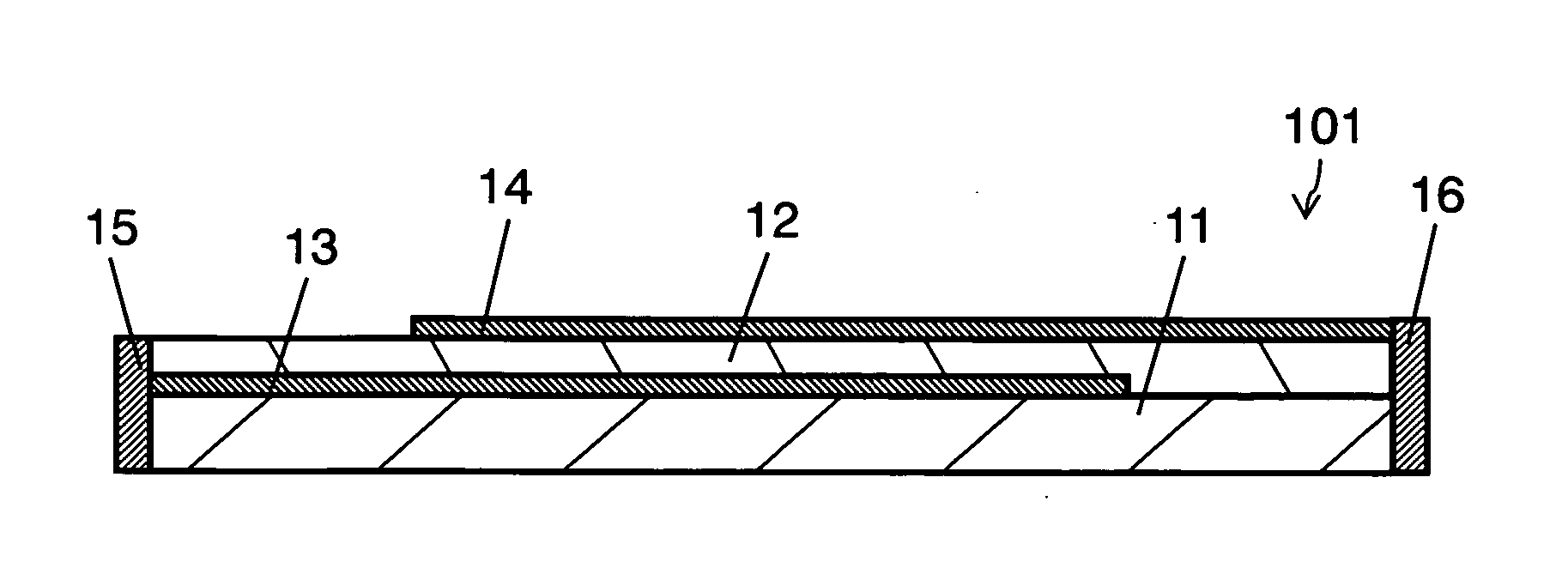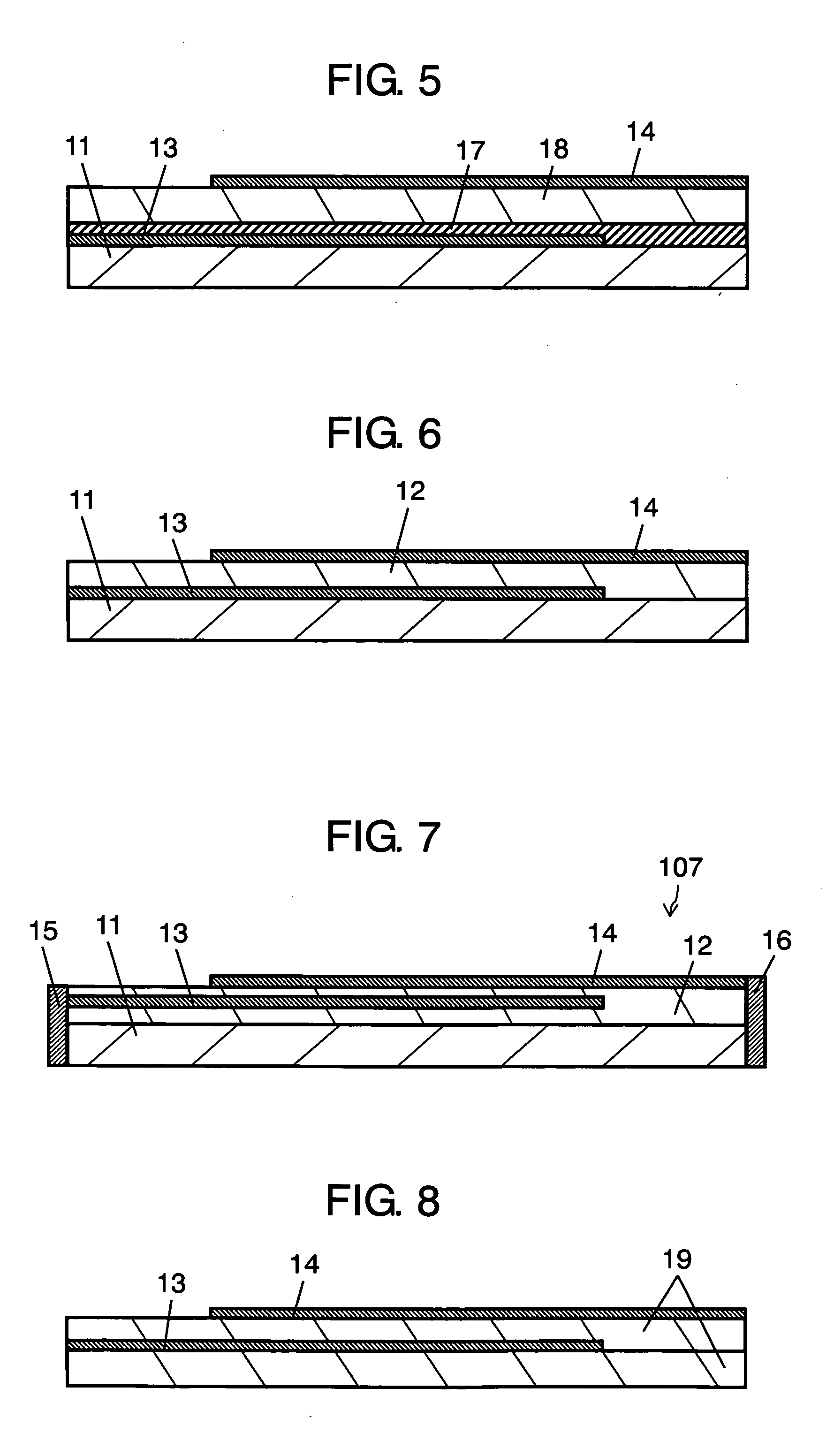Method of manufacturing ESD protection component
- Summary
- Abstract
- Description
- Claims
- Application Information
AI Technical Summary
Benefits of technology
Problems solved by technology
Method used
Image
Examples
first embodiment
[0030] A detailed description is made for a method of manufacturing an ESD protection component according to the first embodiment of the present invention, using an example.
[0031]FIG. 1 is a sectional view illustrating ESD protection component 101 in example 1, according to the first embodiment of the present invention.
[0032] ESD protection component 101 includes ceramic substrate 11, varistor layer 12, conductor layers 13 and 14, and terminal electrodes 15 and 16. In other words, conductor layer 13 is formed with a conductive material such as silver, on ceramic substrate 11 such as 96% alumina, a layer made of a varistor material is formed thereon, and baked, to produce varistor layer 12. Further, conductor layer 14 is provided on this varistor layer 12 to form a varistor element in which varistor layer 12 is sandwiched by conductor layers 13 and 14. Finally, terminal electrodes 15 and 16 that connect to conductor layers 13 and 14, respectively, are provided at both ends of subst...
second embodiment
[0057] In the second embodiment of the present invention, a description is made for the component of adhesive to be used for adhesive layer 17. In the first embodiment, adhesive layer 17 is formed using a solution of polyvinyl butyral and dibutyl phthalate mixed at a weight ratio of 1:10. Varistor particles, and inorganic materials, namely constituent materials for varistor particles, such as zinc oxide, bismuth oxide, cobalt oxide, manganese oxide, or antimony oxide, are dispersed in the solution.
[0058] Table 2 compares the characteristics of an ESD protection component, when changing the kind of an inorganic material dispersed in adhesive layer 17, and its added amount (added amount per 100 g of adhesive). Ten pieces of ESD protection components 107 are produced per each condition using substrates with 15 cm×15 cm. The probability that peeling occurs after baking and the average value of the varistor characteristics a are measured as evaluation items.
[0059] As shown in table 2, ...
third embodiment
[0062] The third embodiment of the present invention describes a relation of the porosity of varistor green sheet 19 shown in FIG. 8 with adhesiveness on alumina substrate 11 and with the varistor characteristic. The porosity of varistor green sheet 19 used in the third embodiment of the present invention is obtained from equation 1 described below.
[0063] In the third embodiment, the pressing pressure and temperature in the transferring or laminating step are changed to control the porosity of varistor green sheet 19. (Porocity)=1-Apparent_density_of_green_seatWeight_of_varister_partcles+Weight_of_binder+Weight_of_plasticize rWeight_of_varister_partclesDensity_of_varister+Weight_of_binderDensity_of_binder+Weight_of_plasticize rDensity_of_plasticize r(Formula _1)
[0064] Ten pieces of ESD protection components 107 shown in FIG. 7 are produced using a layered product of varistor green sheet 19, and the relation is evaluated between the probability that peeling o...
PUM
| Property | Measurement | Unit |
|---|---|---|
| Diameter | aaaaa | aaaaa |
| Diameter | aaaaa | aaaaa |
| Porosity | aaaaa | aaaaa |
Abstract
Description
Claims
Application Information
 Login to View More
Login to View More - R&D
- Intellectual Property
- Life Sciences
- Materials
- Tech Scout
- Unparalleled Data Quality
- Higher Quality Content
- 60% Fewer Hallucinations
Browse by: Latest US Patents, China's latest patents, Technical Efficacy Thesaurus, Application Domain, Technology Topic, Popular Technical Reports.
© 2025 PatSnap. All rights reserved.Legal|Privacy policy|Modern Slavery Act Transparency Statement|Sitemap|About US| Contact US: help@patsnap.com



